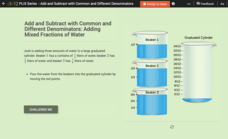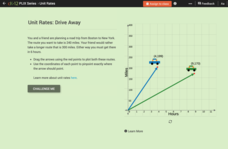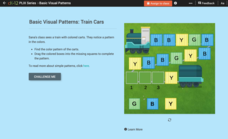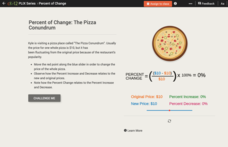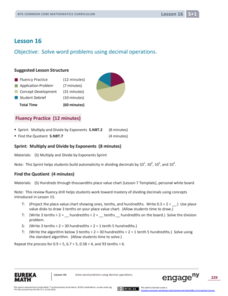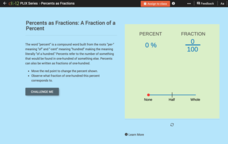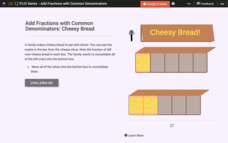CK-12 Foundation
Comparison of Fractions, Decimals, and Percents: Filling in the Squares
An interactive equipped with five questions challenges mathematicians to convert between fractions, decimals, and percents. A diagram changes its size to visually depict conversions alongside symbols to compare them. Question types...
CK-12 Foundation
Mental Math to Divide by Whole Number Powers of Ten: Mental Math to Divide Decimal Powers of Ten
Boost mental-math skills with an interactive that focuses on dividing whole numbers by powers of 10. Mathematicians solve five fill-in-the-blank and multiple-choice questions with help from a moveable decimal point in four example...
CK-12 Foundation
Expression Evaluation with Different Denominators: Adding Mixed Fractions of Water
An interactive challenges mathematicians to add mixed fractions with unlike denominators. Five questions—fill-in-the-blank and multiple-choice—build from one to the next leading the way to an open discussion about denominators and...
CK-12 Foundation
Mental Math to Multiply by Whole Number Powers of Ten: The Rule for Tens
Eight questions challenge scholars to use mental math while multiplying whole numbers by powers of 10. A tool with bouncing decimals demonstrates how and where the decimal moves. Question types include several multiple-choice, a...
CK-12 Foundation
Fractions as Percents: Baking Cookies
A five-question interactive challenges mathematicians to solve word problems involving fractions as percents. Baking two different types of cookies and needing the exact amount requires scholars to make fractions, turn them into...
CK-12 Foundation
Comparison of Unit Rates: Drive Away
Five questions make up an interactive that challenges mathematicians to compare unit rates. Word problems question scholars about two friends going on a road trip. Scholars manipulate two cars on a coordinate plane to help solve word...
CK-12 Foundation
Basic Visual Patterns: Train Cars
An interactive comprised of five questions challenges young scholars to complete a simple pattern. After examining a train with colored carts, learners arrange a green, blue, and yellow block into their corresponding space. Questions are...
CK-12 Foundation
Percent of Change: The Pizza Conundrum
Nine questions—multiple choice and fill in the blank—challenge mathematicians to solve money word problems. Looking closely at prices, scholars use a formula to identify percent increases and decreases based on an original and new price....
CK-12 Foundation
Mental Math to Divide by Whole Number Powers of Ten: Bouncing Decimal Point
Five questions challenge mathematicians to divide whole numbers by powers of 10. A tool highlights how a bouncing decimal moves through the divisor. Question types include multiple choice and fill in the blank. A discussion question...
EngageNY
Grade 5 Math Module 1: Mid-Module Assessment
Show the knowledge learned about decimals. A short assessment covers the material presented in the first half of the unit. Pupils demonstrate their knowledge of comparing, rounding, and multiplying and dividing by powers of 10 with...
EngageNY
Grade 5 Math Module 1: End-of-Module Assessment
The last installment of the 18-part Grade 5 Math Module 1 is an end-of-module assessment. Scholars answer questions that require explaining the connection between powers of 10 and place value, rewriting decimals in different forms,...
EngageNY
Grade 5 Math Module 1, Topic F, Lesson 16
See, decimal operations do come in handy! Pupils solve word problems that require adding, subtracting, multiplying, and dividing decimals. They use tape diagrams to express relationships and to identify the necessary operations to solve...
EngageNY
Grade 5 Math Module 1, Topic F, Lesson 15
Remainders don't need to remain a mystery. The 16th of 18 parts in Grade 5 Math Module 1 continues the study of dividing decimals by a whole number. Scholars see how to rename the remainder to a smaller unit, such as when dividing 1.7 or...
EngageNY
Grade 5 Math Module 1, Topic F, Lesson 14
Be sure to place value on place value understanding. Young mathematicians learn to divide decimals by whole numbers when compatible numbers are not available. They use place value discs in place value charts, then connect this strategy...
EngageNY
Grade 5 Math Module 1, Topic F, Lesson 13
After completing a fluency practice set on subtracting, multiplying, and comparing decimals, pupils begin learning about dividing decimals by whole numbers. They see how to use place value reasoning to find compatible numbers for...
EngageNY
Grade 5 Math Module 1, Topic E, Lesson 12
Continuing from the previous instructional activity, scholars work on mastering the skill of multiplying decimal fractions by a whole number. The method employed in the instructional activity is to convert the decimal fraction to its...
EngageNY
Grade 5 Math Module 1, Topic E, Lesson 11
Let your understanding of multiplying decimals flourish and multiply. After briefly reviewing place value concepts and how to add and subtract decimals, scholars learn to multiply a decimal fraction (like 0.6) by a whole number. They use...
EngageNY
Grade 5 Math Module 1, Topic C, Lesson 7
Step up or step down to rounding. Using a vertical number line, the lesson shows pupils the significance of rounding up or rounding down. Teachers encourage scholars to write the number in unit form and decide which form helped the most...
Curated OER
Mystery Spinners
Take a spin with probability. Given a set of clues about the probability of events on a spinner, groups create their own device to match the clues. Using a jigsaw strategy, groups share their spinners and strategies with other groups....
CK-12 Foundation
Percents as Fractions: A Fraction of a Percent
Five questions make up an interactive all about percents and fractions. Mathematicians answer multiple-choice and fill in the blank problems with help from a tool that converts percents to fractions using a sliding bar. An open...
CK-12 Foundation
Prices Involving Discounts: Save Money with Coupons!
Nine questions make up an interactive that challenges scholars to identify new prices after discounts. Question types include fill in the blank and multiple choice. A fully-functional tool assists participants in solving word problems....
CK-12 Foundation
Properties of Multiplication in Decimal Operations: Balloon Animals
Commutive and associative properties are the focus of a five-question interactive. Dealing with decimal multiplication and addition, mathematicians solve multiple-choice and true or false questions using a model that moves balloons along...
CK-12 Foundation
Sums of Fractions with Like Denominators: Cheesy Bread
Five questions make up an interactive all about adding fractions with like denominators. Mathematicians answer multiple-choice problems and an open-ended question using a fraction model that resembles sliced bread. The practice ends with...
CK-12 Foundation
Subtraction of Fractions: Fragmented Fractions
An interactive challenges scholars to subtract mixed numbers. Pupils answer questions—multiple-choice, fill in the blank, and true or false—with help from virtual fraction strips. The practice closes with a discussion.




